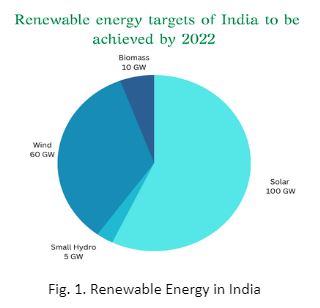


Instruction:
- There will be 2 questions carrying 10 marks each. Write your answers in 150 words
- Any page left blank in the answer-book must be crossed out clearly.
- Evaluated Copy will be re-uploaded on the same thread after 2 days of uploading the copy.
- Discussion of the question and one to one answer improvement session of evaluated copies will be conducted through Google Meet with concerned faculty. You will be informed via mail or SMS for the discussion.
Question #1. In recent times India has been facing extreme water crisis. Why such problem has emerged and give solution to overcome problem of water crisis.
Question #2. “Solar Energy in India is solution to fossil fuel”. Explain.
(Examiner will pay special attention to the candidate's grasp of his/her material, its relevance to the subject chosen, and to his/ her ability to think constructively and to present his/her ideas concisely, logically and effectively).
STEPS & INSTRUCTIONS for uploading the answers
Step 1 - The Question for the day is provided below these instructions. It will be available at 7:00 AM.
Step 2 - Uploading of Answers : Write the answer in A4 Sheet leaving proper margins for comments and feedback and upload the PDF in MY ACCOUNT section. Click on the option of SUBMIT COPY to upload the PDF.
Step 3 - Deadline for Uploading Answers: The students shall upload their answers by 7:00 PM in the evening same day. The first 50 copies will be evaluated.
Step 4 - Feedback : Mentors will give their feedback for the answers uploaded. For more personalised feedback, join our telegram channel by clicking on the link https://t.me/mains_answer_writing_cse . A one-to-one session will be conducted with the faculty after copy evaluation in 72 Hrs.
Model Answer
Question #1. In recent times India has been facing extreme water crisis. Why such problem has emerged and give solution to overcome problem of water crisis.
The world’s oldest civilization grew around the Indus and the Ganges basins. Post-independence, due importance was given to harnessing the power of water by way of controlling and storing water through large Dams. However, our cities and towns have subsequently grown without planning for water need vs water availability. In 1951, the per capita water availability was about 5177 m3. This has now reduced to about 1486 m3 in 2021.
Causes of water crisis in India
In present context, water crisis is mainly man-made due to excess population growth and poor management of water. Reasons for water crisis are observed as:
- Excessive use of water for agriculture: India is among the top agriculture producer in the world and therefore the consumption of water for irrigation is among the highest. Traditional techniques of irrigation cause maximum water loss due to evaporation, drainage, percolation, water conveyance, and excess use of groundwater. As more areas come under traditional irrigation techniques, the stress on water available for other purposes will continue. The solution lies in the extensive use of micro-irrigation techniques such as drip and sprinkler irrigation.
- Reduction in traditional water recharging areas: Rapid construction is ignoring traditional water bodies that have also acted as groundwater recharging mechanisms. We need to urgently revive traditional aquifers while implementing new ones.
- Rising water pollution due to sewage and wastewater drainage into traditional water bodies. Government intervention at the source is urgently required if this problem is to be solved.
- Release of chemicals and effluents into rivers, streams, and ponds. Strict monitoring and implementation of laws by the government, NGOs, and social activists are required.
- Poor water management and distribution of water between urban consumers, the agriculture sector, and industry. The government needs to enhance its investment in technology and include all stakeholders at the planning level to ensure the optimization of existing resources.
Case study of Hyderabad
The problem has been compounded with increased concretization due to urban development that has led to the depletion of groundwater resources. Water is neither being recharged nor stored in ways that optimize its use while retaining the natural ingredients of water. In addition, the entry of sewage and industrial waste into water bodies is severely shrinking the availability of potable water. Marine life is mostly lost in these areas already. This is the genesis of a very serious emerging crisis. If we do not understand the source of the problem, we will never be able to find sustainable solutions.
As an example, Hyderabad is city of several water aquifers and water bodies through time. Osman Sagar and Himayat Sagar lakes were built and have been providing drinking water to the city for well over a hundred years. Excess migration of population to the city coupled with unplanned construction in all directions resulted in traditional aquifers, which existed in and around the city, being blocked.
There are over 4800 bore wells operated by the state-owned HMWS&SB that have been drawing groundwater. The levels have now fallen significantly. If the groundwater cannot recharge, the supply will get only get worse. The demand for water continues to grow while the collection, storage, regeneration, and distribution have become overstressed. The story repeats itself across urban centres in India.
Solutions water scarcity problems
- The amount of water in household task wasted is significant. A small step here can make a significant saving in water consumption.
- Every independent housing colony must have rain water harvesting facility. If efficiently designed and properly managed, this alone can reduce the water demand significantly.
- Waste water treatment and recycling for non-drinking purposes. Several low cost technologies are available that can be implemented in group housing areas.
- Very often, we see water leaking in our homes, in public areas and colonies. A small steady water leak can cause a loss of 226,800 liters of water per year! Unless we are aware and conscious of water wastage we will not be able to avail the basic quantity of water that we need to carry on with our normal lives.
How is the Government tackling the situation?
- The Government has launched many initiatives like Jal Shakti Abhiyan (JSA), Catch the Rain Campaign, National Perspective Plan for Water Resources, and Jal Jeevan Mission (JJM)-Har Ghar Jal.
- Under the JSA, it was the government’s goal to improve water availability and even improve the groundwater conditions in the 256 marked water-stressed districts in India. States like Punjab and Haryana have been facing extreme stress on their groundwater level, the water has receded 9.2 meters which is the highest among all the states in the country.
- In 2021, the catch the rain campaign was introduced by Prime Minister Narendra Modi which aims to conserve Rainwater in all the districts of the country.
- The current regime has also been implementing schemes like Jal Jeevan Mission in which the Central government along with the State government wants to provide potable and adequate water to every rural household including the tribal areas in the country with a tap connection by 2024.
Conclusion:
In the age of global warming when almost all countries are facing water crisis directly or directly, water management has become a focus area of policy framing. India also need to focus upon this crisis before it becomes a unrepairable issue.
Question #2. “Solar Energy in India is solution to fossil fuel”. Explain.
The Sun has been worshiped as a life-giver to our planet since ancient times. The industrial ages gave us the understanding of sunlight as an energy source. India is endowed with vast solar energy potential. About 5,000 trillion kWh per year energy is incident over India's land area with most parts receiving 4-7 kWh per sq. m per day. Solar photovoltaic power can effectively be harnessed providing huge scalability in India. Solar also provides the ability to generate power on a distributed basis and enables rapid capacity addition with short lead times. Off-grid decentralized and low-temperature applications will be advantageous from a rural application perspective and meeting other energy needs for power, heating and cooling in both rural and urban areas. From an energy security perspective, solar is the most secure of all sources, since it is abundantly available. Theoretically, a small fraction of the total incident solar energy (if captured effectively) can meet the entire country's power requirements.
India’s Potential in Solar Energy
- The calculated solar energy incidence on India's geographical area is roughly 5 quadrillion kilowatt-hours (kWh) per year (or 5 EWh/yr) with about 300 clear and sunny days per year.
- Solar energy available in a single year is greater than the combined energy production of India's fossil fuel reserves.
- In India, the daily average solar-power-plant generating capacity is 0.30 kWh per m2 of usable land area, which translates to 1,400–1,800 peak (rated) capacity operating hours per year using commercially proven technology.
- India initiated a $40 million experiment in June 2015 to detect solar radiation with a spatial resolution of 3 by 3 kilometres.
- The Indian solar-radiation atlas is built on the foundation of this solar-radiation measurement network.
- The National Institute of Wind Energy, Ministry of New and Renewable Energy, has deployed solar radiation resource assessment (SRRA) stations around India to develop a database of solar-energy potential.
- The Centre for Wind Energy Technology collects and reports data (C-WET).
- Global Horizontal Irradiance (GHI), Direct Normal Irradiance (DNI), and Diffuse Horizontal Irradiance are some of the metrics measured (DHI).
Government Initiatives
Kisan Urja Suraksha evam Utthaan Mahabhiyan (Kusum Scheme)
- The Central Government has announced the Kisan Urja Suraksha evam Utthaan Mahabhiyan (KUSUM) scheme, which aims to increase solar electricity output in India while also providing farmers with the benefits of solar farming.
- The Kusum Scheme is carried out by: The Ministry of New and Renewable Energy is in charge of this project.
- Initially, 1.75 million off-grid agricultural solar pumps will be distributed by the government.
- 10, 000 megawatts Solar panels will be installed on barren ground.
- The state electricity distribution firms, or DISCOMS, will purchase the extra solar energy generated by farmers on barren fields. DISCOMS will be given incentives to purchase this electricity.
- The government's tube wells and existing pumps will be adapted to run on solar power.
International Solar Alliance
- The international solar alliance has been granted observer status by the United Nations General Assembly, six years after it was jointly founded by France and India.
- It's a historic move that will pave the way for clear cooperation between the ISA and the UN, as well as promote global energy development.
- The ISA was developed in 2015 as a joint effort by India and France during the United Nations Climate Change Conference of Parties' 21st session.
- The alliance was founded with the goal of promoting solar energy in member nations and mobilising over $1 trillion in funding for solar energy installations at a low cost.
- The International Solar Alliance (ISA) is a group of countries with abundant solar resources that are located entirely or partially between the Tropics of Cancer and the Tropic of Capricorn.
One Sun, One World, One Grid (OSOWOG)
- The One Sun One World One System (OSOWOG) is a global electricity grid that distributes power around the world.
- Prime Minister Narendra Modi first proposed the initiative at the International Solar Alliance's (ISA) inaugural assembly in 2018.
- According to the Ministry of New and Renewable Electricity's (MNRE) proposal, the OSOWOG will have a large size, intending to offer energy to around 140 countries via a single system that will transport solar power.
- The OSOWOG's philosophy is that 'The Sun Never Sets,' and that it is always present in some geographical spot, globally, at any given time.
- The programme will aid in the realization of energy development's "three transitions."
- The shift from fossil fuel to clean energy dominance in energy production.
- The shift in energy allocation from local equilibrium to cross-border and worldwide distribution, as well as
- The shift in energy consumption from coal, oil, and gas to electric-centric usage.
National Solar Mission
- The Jawaharlal Nehru National Solar Mission, often known as the National Solar Mission, is one of India's National Action Plan on Climate Change's eight main National Missions (NAPCC).
- NAPCC was established on June 30, 2008, with the goal of making solar energy technology development a national mission.
- The mission was approved by the government on January 11, 2010.
- In June 2015, the Mission lowered its lofty objective of deploying 20,000 MW of grid-connected solar power by 2022 to 1,00,000 MW by 2022.
- The National Solar Mission's goal is to make India a global leader in solar energy by establishing the policy circumstances that will allow it to spread as swiftly as possible across the country.
Roof top Solar Scheme
- The Ministry of New and Renewable Energy launched a rooftop solar program.
- The Grid-Connected Rooftop Solar Scheme (Phase II) is now being implemented: Rooftop Solar Projects are expected to generate a total capacity of 40,000 MW by 2022.
- Distribution companies (DISCOMs) in the state are implementing this scheme.
- The Ministry will provide a 40% subsidy for the first 3 kW of solar panel capacity and a 20% subsidy for the next 3 kW and up to 10 kW of solar panel capacity under this programme.
- The cost of a rooftop solar plant must be paid by the residential customer by reducing the subsidy amount supplied by the Ministry to the vendor at the stipulated rate.
National Wind-Solar Hybrid Policy 2018
- The Ministry of New and Renewable Energy adopted the National Wind-Solar Hybrid Policy on May 14, 2018. (MNRE).
- It's a campaign to promote a huge grid-connected wind-solar PV hybrid system that makes efficient use of transmission lines and land.
- The National Wind-Solar Hybrid Policy also intends to reduce renewable power generation unpredictability and improve grid stability.
- The following are the major objectives of the National Wind-Solar Hybrid Policy:
- Provide a comprehensive framework for promoting big grid-connected wind-solar photovoltaic (PV) hybrid systems that make efficient use of transmission infrastructure and land.
- Reduce renewable energy generation fluctuation and improve grid stability.
- Encourage the development of novel technologies, methods, and workarounds that combine the functioning of wind and solar PV systems.
Conclusion
During the last few years, solar energy has had a noticeable impact on the Indian energy landscape. Millions of people in Indian communities have been benefitted. India's solar energy sector has grown to become a prominent player in grid-connected power generation capacity throughout the years. It promotes the government's agenda of long-term growth while also establishing itself as an important contributor to meeting the country's energy demands and a key role in ensuring energy security.



